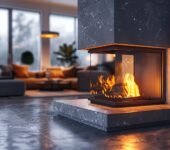Table of Contents
- 1 What is Carbon Monoxide?
- 2 What are the Sources of Carbon Monoxide?
- 3 What is a Carbon Monoxide Detector?
- 4 How Does a Carbon Monoxide Detector Work?
- 5 Why Do I Need a Carbon Monoxide Detector with My Fireplace?
- 6 How Do I Choose the Right Carbon Monoxide Detector for My Fireplace?
- 7 Where Should I Place My Carbon Monoxide Detector?
- 8 How Often Should I Test and Replace My Carbon Monoxide Detector?
- 9 What Should I Do if My Carbon Monoxide Detector Goes Off?
- 10 How Can I Prevent Carbon Monoxide Poisoning from My Fireplace?
- 11 Frequently Asked Questions
Curled up by a cozy fireplace, sipping on hot cocoa, the last thing on your mind may be carbon monoxide poisoning. Do you need a carbon monoxide detector when you have a fireplace?
This silent, odorless gas can pose a serious threat, especially when using a fireplace.
Learn about the sources of carbon monoxide, the importance of having a detector with your fireplace, how to choose the right one, placement tips, testing frequency, and what to do in case of an alarm.
Stay informed and keep your home safe!
What is Carbon Monoxide?
Carbon monoxide is a colorless, odorless gas that poses a serious threat to household safety. It is produced by the incomplete combustion of gas and fuels in household appliances, leading to potential risks of poisoning. This gas can be extremely toxic when inhaled, causing a range of health hazards.
Symptoms of carbon monoxide exposure include headaches, dizziness, nausea, confusion, and fatigue, often mistaken for the flu. Prolonged exposure can lead to more severe outcomes, including unconsciousness and even death. This silent killer is especially dangerous in enclosed spaces like homes where ventilation may be insufficient.
Installing carbon monoxide detectors in key areas of the house, such as near bedrooms and kitchen areas, is vital to alert occupants of any dangerous levels. Regular maintenance of gas appliances and proper ventilation practices are crucial for preventing carbon monoxide buildup.
What are the Sources of Carbon Monoxide?
The primary sources of carbon monoxide in homes are gas appliances such as furnaces, water heaters, and stoves that rely on the combustion process to function. Improperly maintained chimneys or blocked ventilation systems can also contribute to the buildup of carbon monoxide indoors.
It is essential for households to understand that these gas-fueled appliances, if not properly installed or maintained, can release dangerous levels of carbon monoxide.
Chimneys play a crucial role in safely expelling combustion byproducts, including carbon monoxide, outside the home. Ensuring that chimneys are clear of obstructions and functioning correctly is vital for preventing carbon monoxide infiltration. Adequate ventilation, both natural and mechanical, is key in allowing carbon monoxide to dissipate harmlessly.
Regular inspections, maintenance, and compliance with safety standards can significantly reduce the risk of carbon monoxide leaks, safeguarding the well-being of occupants.
What are the Common Sources in a Home?
Common sources of carbon monoxide in a home include gas furnaces, water heaters, stoves, and fireplaces, all of which rely on combustion processes. Improper ventilation, blocked chimneys, or inadequate maintenance of these appliances can increase the risk of carbon monoxide leaks.
These gas appliances are standard in many households, providing essential functions such as heating, cooking, and hot water. Gas furnaces operate by burning fuel to generate heat, water heaters use gas to heat water for domestic use, stoves rely on gas combustion for cooking meals, and fireplaces burn gas for warmth and ambiance.
Ensuring that these appliances are properly maintained and adequately ventilated is crucial for preventing the buildup of carbon monoxide, a colorless and odorless gas that can be highly dangerous if inhaled in high concentrations.
What is a Carbon Monoxide Detector?
A carbon monoxide detector is a safety device designed to alert occupants of a home to the presence of dangerous levels of carbon monoxide gas. It functions by monitoring the air for the gas and triggering an alarm to warn individuals of potential exposure.
These detectors are crucial in preventing carbon monoxide poisoning, as this colorless, odorless gas can be deadly when inhaled in high concentrations. The detectors typically use sensors to detect the gas in the air, with different models offering varying levels of sensitivity. With the ability to detect low levels of carbon monoxide early on, these devices provide valuable time for occupants to evacuate and seek medical assistance before serious health effects occur.
How Does a Carbon Monoxide Detector Work?
Carbon monoxide detectors operate using advanced detection technology that can sense the presence of the gas in the air. When elevated carbon monoxide levels are detected, the device emits a warning signal, alerting occupants to a potential gas leak and the need for immediate action.
This detection technology typically involves electrochemical sensors that react to carbon monoxide molecules in the air. Once these sensors come into contact with the gas, they trigger a process that sets off the alarm. This rapid response is crucial in ensuring the safety of individuals by providing early alerts before the gas reaches dangerous levels. By promptly signaling the presence of carbon monoxide, these detectors play a vital role in averting potential health risks and preventing carbon monoxide poisoning incidents.
Why Do I Need a Carbon Monoxide Detector with My Fireplace?
A carbon monoxide detector is essential when using a fireplace to detect any potential gas fumes or carbon monoxide emissions. Fireplaces can be a source of carbon monoxide buildup, posing a significant fire hazard and health risk to occupants.
Carbon monoxide is a colorless, odorless gas that can be deadly if inhaled in high concentrations. The danger lies in the fact that it’s virtually undetectable without a specialized detector. This is particularly concerning in the case of fireplaces, where incomplete combustion of fuel can lead to the release of this toxic gas. Early detection through a carbon monoxide detector is crucial to ensure the safety of those in the vicinity and prevent potential health complications or even fatalities.
What are the Dangers of Carbon Monoxide from a Fireplace?
Using a fireplace without proper ventilation or monitoring for carbon monoxide can lead to dangerous levels of this gas accumulating in the home. The resulting health risks, including carbon monoxide poisoning, and the fire hazard posed by uncontrolled emissions necessitate stringent safety measures.
Carbon monoxide is a silent killer, as it is colorless and odorless, making it extremely difficult for occupants to detect its presence. Without proper precautions, individuals in the household can experience symptoms such as headaches, dizziness, nausea, and even death from prolonged exposure to high levels of carbon monoxide.
The risk of fires breaking out due to the buildup of this poisonous gas adds another layer of danger. To safeguard against these threats, it is crucial to install carbon monoxide detectors in key areas and conduct regular maintenance on both the fireplace and the detectors for optimal functioning and early detection.
How Do I Choose the Right Carbon Monoxide Detector for My Fireplace?
Selecting the appropriate carbon monoxide detector for your fireplace involves considering factors such as the detector’s placement, functionality, and compatibility with gas appliances. Proper installation according to safety guidelines is crucial to ensure effective monitoring.
When choosing a carbon monoxide detector for use with your fireplace, it’s essential to select one that can detect even low levels of CO to ensure early detection of potential leaks. Consider a detector that is battery-operated or has a backup power source to maintain functionality in case of power outages. Ensure the detector is placed at a suitable height and distance from the fireplace to effectively detect any CO emissions. Following the manufacturer’s installation instructions will help optimize the detector’s performance and provide reliable safety measures for your home.
What Features Should I Look for in a Carbon Monoxide Detector?
When choosing a carbon monoxide detector, it is essential to look for features such as a reliable detection system that meets safety standards and regulations. Ensuring the detector’s accuracy and responsiveness is crucial for effective monitoring.
Opting for a detector equipped with advanced sensor technology can provide real-time monitoring and instant alerts in case of any CO presence. Considering detectors with backup power sources, like batteries, ensures continuous functionality during power outages. Look for models with digital displays or smart features for easy reading and remote access to monitor CO levels. Some detectors also offer interconnected capabilities, allowing multiple units to communicate and sound alarms simultaneously throughout the premises for enhanced safety.
What Types of Carbon Monoxide Detectors are Available?
There are several types of carbon monoxide detectors available, including plug-in, battery-operated, and hardwired models. Each type utilizes different detection methods to raise awareness of elevated carbon monoxide levels and ensure prompt action.
Plug-in carbon monoxide detectors are convenient as they can be easily plugged into any outlet, providing continuous monitoring. Battery-operated models offer flexibility by functioning even during power outages, making them reliable in emergencies. On the other hand, hardwired detectors are directly connected to the electrical system, offering seamless integration for consistent monitoring. Regardless of the type, carbon monoxide detectors play a crucial role in alerting individuals to dangerous levels of this odorless gas, enabling them to take necessary precautions to prevent carbon monoxide poisoning.
Where Should I Place My Carbon Monoxide Detector?
Positioning your carbon monoxide detector strategically is crucial for effective monitoring. Install detectors near potential sources of carbon monoxide, such as gas appliances, ensuring proper ventilation and coverage throughout your home.
Consider placing detectors in key areas like bedrooms and hallways to provide comprehensive coverage in case of a carbon monoxide leak. Remember to test your detectors regularly and replace batteries as needed to ensure they are functioning properly. It is also advisable to have multiple detectors on different levels of your home to increase the chances of early detection. By following these guidelines, you can help protect your household from the silent threat of carbon monoxide poisoning.
How Often Should I Test and Replace My Carbon Monoxide Detector?
Regular testing of your carbon monoxide detector is essential to ensure its functionality and reliability. It is recommended to test the detector monthly and replace its batteries annually to maintain continuous safety precautions.
Testing your detector regularly not only helps in early detection of potential gas leaks but also ensures that it remains in proper working condition. By testing monthly, you can promptly address any issues that may arise and avoid the risk of malfunction during emergencies. Replacing the batteries annually is crucial in guaranteeing that your detector functions optimally. This simple routine can significantly contribute to safeguarding your home and loved ones from the dangers of carbon monoxide exposure.
What Should I Do if My Carbon Monoxide Detector Goes Off?
If your carbon monoxide detector alarm activates, it is crucial to respond promptly with an emergency plan. Evacuate the premises, call emergency services, and conduct a risk assessment to identify the source of the carbon monoxide leak.
Ensure all individuals in the vicinity are evacuated to a safe location away from the affected area. Contact authorities immediately to report the alarm and seek further assistance.
Once outside, take deep breaths of fresh air and avoid re-entering the building until it has been declared safe. Upon investigating the potential source of the leak, refrain from turning on any lights, as this could potentially ignite any accumulated gases.
Remember that carbon monoxide is a silent and odorless threat, requiring swift and decisive action to ensure everyone’s safety.
How Can I Prevent Carbon Monoxide Poisoning from My Fireplace?
Preventing carbon monoxide poisoning from your fireplace involves practicing safe usage and implementing effective safety measures. Ensure proper ventilation, regular maintenance, and the installation of carbon monoxide detectors to mitigate the risks associated with fireplace emissions.
Proper ventilation is crucial to ensure that any carbon monoxide produced by the fireplace is effectively vented outside, preventing its buildup indoors. Regular maintenance, such as cleaning the chimney and checking for blockages, helps ensure that the fireplace operates efficiently and reduces the risk of carbon monoxide leaks. Installing carbon monoxide detectors in key areas of your home provides an added layer of protection by alerting you to any dangerous levels of this colorless, odorless gas in the air.
Frequently Asked Questions
1. What is carbon monoxide?
Carbon monoxide is a colorless, odorless gas that can be toxic, produced by incomplete combustion in gas appliances, posing serious health risks.
2. Why is a carbon monoxide detector necessary with a fireplace?
Installing a carbon monoxide detector with a fireplace is crucial for detecting any leaks of this dangerous gas, preventing potential poisoning and ensuring safety.
3. What types of carbon monoxide detectors are available?
Available carbon monoxide detectors include plug-in, battery-operated, and hardwired models, each offering specific features for effective carbon monoxide monitoring.
4. Where should I place my carbon monoxide detector?
Place carbon monoxide detectors near bedrooms and living areas and on each level of your home to ensure comprehensive coverage and early detection of gas leaks.
5. How often should I test and replace my carbon monoxide detector?
Test your carbon monoxide detector monthly and replace its batteries annually to maintain its functionality and reliability for home safety.
6. What should I do if my carbon monoxide detector goes off?
If your carbon monoxide detector alarms, evacuate immediately. Next, call emergency services for assistance, and do not re-enter the premises until it’s safe.
Latest Articles

What Is Fireplace Over-Firing?
Table of Contents1 What Is Fireplace Over-Firing?2 What Causes a Fireplace to Over-Fire?3 What Are the Signs of Over-Firing?4 What Are the Dangers of Over-Firing?5

What Type Of Fireplace Is Most Efficient?
Table of Contents1 Factors to Consider When Choosing a Fireplace2 Types of Fireplaces3 Which Type of Fireplace is the Most Efficient?4 Other Factors to Consider

How a Fireplace Flue Damper Can Improve Your Heating Efficiency
Table of Contents1 What is a Fireplace Flue Damper?2 How Does a Fireplace Flue Damper Work?3 What are the Benefits of Using a Fireplace Flue



















































































